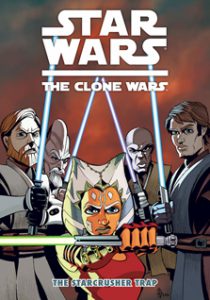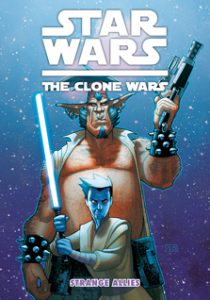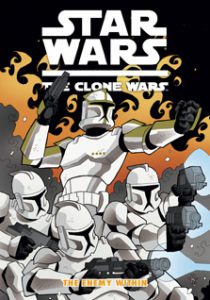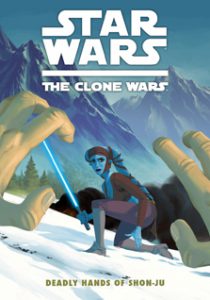“The Clone Wars” digests continue to deliver a mixed bag of supplementary material to the TV show with Nos. 5-8 (2010-12), featuring good yarns about Aayla Secura and the clones and a strong “Secret Missions” tie-in, but also a shallow Obi-Wan/Anakin/Ahsoka story.
Aayla Secura was one of the best characters in the “Republic” comics, but arguably her feelings about touching the dark side and losing her memory were underexplored compared to her master, Quinlan Vos, who goes through a similar experience. Jeremy Barlow’s “Deadly Hands of Shon-Ju” (December 2010) rectifies this somewhat as Aayla rediscovers her spirit and loyalty to the Jedi Order. It’s a bit disappointing that it comes by contrasting herself against another character, Shon-Ju, who makes excellent points about the hypocrisy of the Jedi Order before undermining it with his own faults. Still, he’s a good character for the first half of the book, the latest example of a rogue Force-user who starts his own sect outside of the Order. (And similar to how Laranth from “Coruscant Nights” eschews lightsabers for guns, Shon-Ju favors his hands; he’s basically a karate master.)
The war profiteer Attuma Duum, who lures the Republic and the Separatists into a minefield largely to enjoy the fireworks, is a good villain, and I enjoy Barlow’s promise in the final panels that both Duum and Shon-Ju will re-emerge, and that Dooku might be interested in recruiting the latter. However, neither appears again.

Mike W. Barr’s “The Starcrusher Trap” (July 2011) is step down. Raymund Lee’s moody coloring of the Fillbach Brothers’ art stands out, and the plot about Obi-Wan, Ahsoka and others trying to destroy a Separatist superweapon through infiltration is familiar — although Obi-Wan’s magnetizing of the hull is clever. The page-to-page flow and dialog are predictable, right down to Anakin disobeying orders to save the day. Weirdly, Mace Windu is just along for the ride – someone with Mace’s powerful presence shouldn’t be in a story unless he has something significant to contribute. And while Barr’s original Jedi, Jyl Somtay, develops a bond with Ahsoka and speaks of growing up in the Temple with Anakin, she appears in no other stories with those characters.

Ryder Windham’s “Strange Allies” (November 2011) gets the digest series back on track. It ties in to Windham’s four-book young-adult “Secret Missions” series that chronicle master-less Padawan Nuru Kungurama, a Chiss, and the mercenary Big Gizz from the “Shadows of the Empire” comic series. It’s interesting to see Gizz in his younger days, when he still has a decent heart — which tends to get broken by females – to go along with his uncouth behavior. The twisty plot eventually finds the duo escorting orphaned kids, and for continuity buffs, it’s nice to visit Affa (where C-3PO was allegedly activated, according to Russ Manning’s “The Constancia Affair,” “Episode I” notwithstanding) and Fondor (from the Goodwin/Williamson strips). Supplemented by crisp art by Ben Dewey, it ends up as the richest “Clone Wars” graphic novella up to this point.


Barlow’s “The Enemy Within” (March 2012) is a decent story about the clone Banks (so named for his ability to make bank-shots with blaster bolts) who takes on a turncoat commander and a turncoat clone within his ranks, although the stories about the defectors are not particularly deep. (A stronger clone defector yarn is Season 2’s “The Deserter,” and Karen Traviss’ “Republic Commando” novels dealt in-depth with the complex desertion plans of Skirata’s clones.) “The Enemy Within” is the latest example of time being spent to create an interesting character, only for that character to never be seen again.
Through eight of the 11 entries, the “Clone Wars” digests seem to be a catch-all title for authors to tell whatever stories they want – about main characters or side characters, aimed at kids or aimed at wide audiences. We don’t know what we’re gonna get until we open each book.

